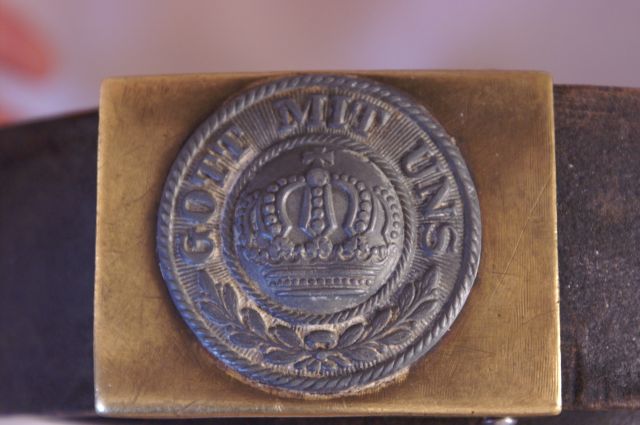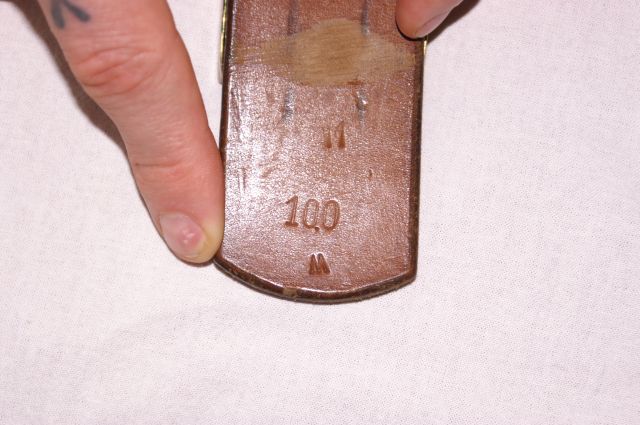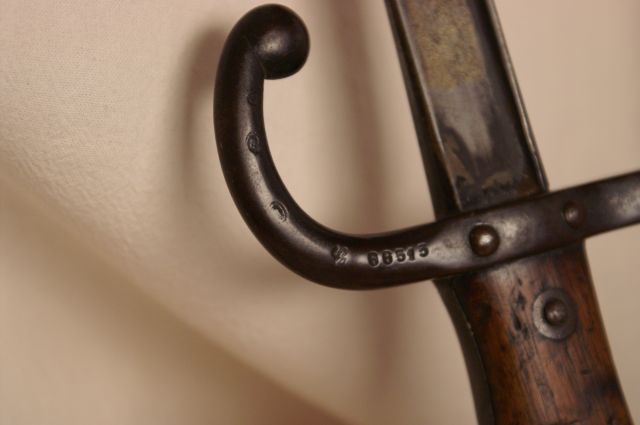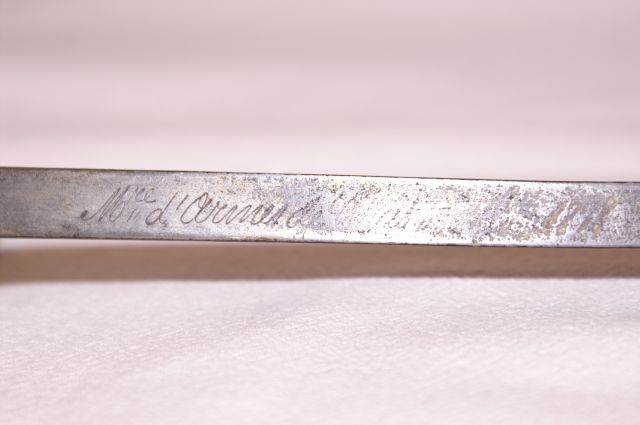Some time ago I was approached by a friend and colleague at work. He knew of my burgeoning interest in most things militaria. He claimed to have in his possesion a genuine SS belt buckle bearing the famous legend "GOTT MIT UNS". This of course peaked my interest. He also, at the the same time, wanted to sell me a Gras bayonet from the 1800's. This peaked my interest some more. He had acquired the items in his native country of Finland from a local antique dealer with whom his parents were acquianted. Needless to say, a deal was made and I bought the items from him.
However, some things bothered me about the belt. Or more correctly: the buckle itself. For one thing I knew that the SS in general would have used some other legend than "GOTT MIT UNS". And the lack of a swastika and a SS insignia was something of a tell tale sign that some things were not as they "should" be. I soon as I got home I delved into some research on the objects I know had in my possesion. Within short my suspiscions were confirmed: it was not an SS belt. In fact, this was something far more intriguing. The legend of "GOTT MIT UNS" was used during both WWII as well as WWI. However during WWII it was the Wehrmacht -not the SS- that used the legend in question. The SS used the legend "Meine Ehre Heisst Treue" [My Honour Is Called Loyalty] on their belt buckles. Though, as I stated, during WWII the regular armed German forces still used the "GOTT MIT UNS" legend. But their particular belt buckles also featured the eagle and swastika -which was notably absent from my belt buckle. The main difference between the WWI and WWII Wehrmacht belt buckle was the insignia itself: The WWI belt buckle featured a Prussian symbol of royal crown. I believe that the gentle reader of this little tale now might be guessing at what I am aiming at. And yes, you are most correct. The belt buckle tuned out to be a buckle from the first world war. To my great delight I might add. Little did I know that I was to be even more delighted further on...
Now, the second thing to perplex me even further was the so called "bayonet". A quick browsing of well informed sites on the internet quickly affirmed its status as a French Gras m1874 bayonet from the latter half of the 1800's. However something was, yet again, amiss. My bayonet was just too short. The standard length of a Gras bayonet is close to 25.5 inches. However my bayonet seemed to lack about 9 inches of blade since it only had a total length of 14.5 inches! And no amount of dilligent research could bring up a variant of the bayonet that would measure 14.5 inches. Not any regular Gras models anyway. It was not until I came across a Swedish online article on fighting knives that a highly enjoyable revelation came to me. I had studied the blade on my Gras very closely. It bore the correct inscriptions and everything, but like I stated earlier the blade was too short. But, if one studied the end of the blade very closely, there were clear marks of tampering to be found. Small marks, similar to those stemming from grinding and filing marred the heavily patinated blade. This little detail, along with the Swedish article, brought light to why my "bayonet" was so short. During WWI it was common for troops to take old bayonets and shorten then to use them as fighting knives in the trenches. So there it was: my 1870's bayonet had, sometime between 1914-1918, been transformed it to a really well balanced fighting knife!
Now I know that most of you are probably scratching your beards (or clean shaven chins) thinking: "Now how in the name of all decent research did he come to that haphazard conclusion?!" Well, the story does not quite end here. Remeber the byline in the beginning of my post. Also remember the Finish "origin" of the items and the acquitance of my friend's parents. I checked with him to be sure after making some more research-related discoveries. And he confirmed my suspicions. The items had been found in tucked away in a dusty old attic, both of them most likely in the same attic, and had been bought up by the antique dealer as part of an estate auction of goods from the former, now desceaced, occupant of the house. The thing that ties these two, seemingly unrelated, items together is this: during WWI Finland had a number of volounteers who fought for the German side during the war.
"Soon after Finland gained independence in December 1917, a nationalistic, middle-class militia known as the White Guards, which had been secretly established in 1904 and 1905 and which had remained underground since then disguised as athletic clubs and other groups, was officially proclaimed the army of the Finnish government under General Mannerheim. This so-called White Army was strengthened and trained by 1,100 officers and noncommissioned officers (NCOs) who had traveled clandestinely to Germany during World War I and had formed the Twenty-seventh Royal Prussian Jaeger Battalion. Returning to Finland, they brought back with them urgently needed small arms captured from the Russians. The White forces were swelled by new conscripts, officers of the former Finnish armed forces, Swedish volunteers, and Finnish officers who had served in the Swedish and in the Russian armies, in addition to the jaegers. After three months of bitter civil conflict, the White Army of about 70,000 troops defeated the Red Guards from the radical wing of the Finnish Social Democratic Party, in May 1918. Both sides suffered thousands of casualties. In four months, the White Guards had evolved from a strongly motivated, but ill-trained, militia into a battle-hardened, disciplined national armed force. Although numerically superior and reinforced by the Russian garrisons in Finland, the Red Guards were deficient in equipment, training, and leadership (see The Finnish Civil War , ch. 1).
The Jäger troops were volunteers from Finland in Germany trained as Jägers (elite light infantry) during World War I. It was one of many means by which Germany intended to weaken Russia and to cause Russia's loss of western provinces and dependencies.
The recruitment of the Jäger volunteers from the Russian Grand Duchy of Finland had to be secret, and was dominated by Germany-influenced circles, such as university students and the upper middle class. The recruitment was however in no way exclusive.
The recruits were transported across Finland's western border via Sweden to Germany, where the volunteers were formed into the Royal Prussian 27th Jäger Battallion. The Jäger Battallion participated in the ranks of the German Army from 1916 in the battles on the northern flank of the eastern front.
After the outbreak of the Civil War in Finland Jägers who intended to engage on the "White" (non-Socialist) side in the war were released. In Finland, these 2,000 volunteers were simply called The Jägers (Finnish pl. Jääkärit).
Their contribution to the White victory was crucial, not least through improving morale. Educated as elite troops they were also fit to assume command as officers over the untrained and uneducated troops of the Civil War.
Immediately after the Civil War, they were afforded the right to use the word Jäger in their military ranks. Many of the Jägers continued their military careers. In the 1920s a long feud between officers with Jäger-background and Finnish officers who had served in the Russian Imperial army was concluded in favor of the Jägers: Most of the commanders of army corps, divisions and regiments in the Winter War were Jägers. The Jäger March composed by Jean Sibelius to the words written by the Jäger Heikki Nurmio, was the honorary march of many army detachments.
[Information taken from: http://www.country-data.com/cgi-bin/query/r-4716.html and http://en.wikipedia.org/wiki/Finnish_J%C3%A4ger_troops ]
All this, the Prussian belt and its buckle, the bayonet-turned-fighting-knife, the find-place of the items and the historical facts regards the Finnish volounteers all point towards one thing: The fighting knife and the belt and buckle belonged to a Finnish Jäger volounteer, who after the war returned home and hid away part of his equipment in the attic where it then lay hidden until the end of the century. The fighting knife, seeing as to how it is originally French in origin could have been acquired by him during the war when he was in Germany. Now, I am not stating all this as fact. It is speculation of course, but the thought is, without a doubt both probable as well as extremely intriguing.
So, without further ado:
WWI Prussian belt and buckle
The belt itself is original and in excellent shape. Almost a 100 years have not taken their due toll. The leather is, in fact still soft, and only slightly worn. The buckle itself is hardly even patinated. Given that it spent the close to 70-80 years in an old attic it is in remarkable condition. One end of the leather belt is stamped with the letter "B" and the end under the buckle is stamped with "1", "10.0" and "W" (or possibly "M").
M1874 Gras bayonet converted into fighting knife
The fighting knife is in a slightly more agred condition. Its blade is quite heavily patinated and also slightly bent and the edge have become slightly dulled. The gently tapering blade have a very strong T-cross section, which is almost reminiscent of certain rondel daggers. Although an edge is present, this I imagine to mainly be a stabbing weapon.The patination on the blade is so severe that it borders on black on some parts. The wooden and brass handle is in very good condition (seeing as to it having seen use). The wood is still intact and is not even cracked. Even the old locking mechanism still work. The hilt features a strong, hooked crossguard which bears a number of stamps; four to be exact. One of them is the letter "B", but the others are too worn to be properly identified. I do know though that the they are the director and inspector stamps. The serial number is still clearly visible though: "66513". This is actually the serial number of the rifle to which the former bayonet once belonged to, and the number itself denotes the arsenal where the rifle was made.
As a fighting knife the weapon is excellently balanced. It lies well in the hand and changes between hammer grip and ice-pick grip can easily be made. I have actually used it exstensively for floryshing rondel dagger techniques, and in this aspect it works like a charm. Seeing as to how similar tools this particular fighting knife and the rondel dagger would be, one is not so far off when using such techniques either. It can even be utilized with the upper and lower shields (where the blade itself is gripped with one hand) of the rondel dagger work. If used in a hammer grip the brass "pommel" lends itself very well to bashing pommel strikes if one was to end up close with the enemy. The hooked croos guard also helps in situations very some where close work is needed to be done. I can very clearly see good reasons for this weapon to be used in the confines of a trench system.
Total length: 14.5"
Blade length: 9.75"
Blade width at base: .75"
Blade with "on top of the T": .40"
Total width of cross: 4"
Hilt length: 4.25"*
*Seeing as to how I am a man of the metric's system and the system of inches on my tape measurer confuse me to no end please bear with me if these numbers seem weird or off.

The buckle itself. The legend "GOTT MIT UNS" and the Royal Prussian crown is clearly visible. Hardly any patination at all.

The end-flap of the belt. Stamps clearly visible. Also note the likewise excellent condition of the belt itself.

The fighting knife itself. Note the reshaped tip on the blade.

Crossguard with stamps. Serial number of rifle clearly visible in this shot.

Back of blade with engraving of the name of the arsenal and the date of manufacture OF THE BLADE, month and year. The thick patina obscures most of it but the arsenal; "Chatlt" (Chatellerault) can just be made out. Month obscured. Year 1878 (or1879).